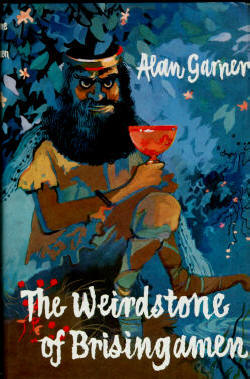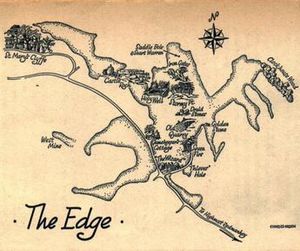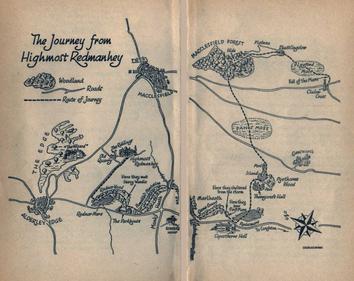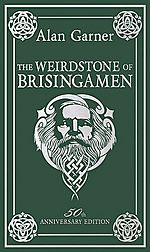The Weirdstone of Brisingamen facts for kids

The 1960 first edition of the book.
|
|
| Author | Alan Garner |
|---|---|
| Cover artist | George Adamson |
| Country | United Kingdom |
| Language | English |
| Genre | Children's novel, Fantasy |
| Publisher | William Collins, Sons |
|
Publication date
|
1960 |
| Media type | Print (hardback & paperback) |
| Pages | 224 |
| ISBN | 0-529-05519-8 |
| OCLC | 4593190 |
| LC Class | PZ7.G18417 We 1979 |
| Followed by | The Moon of Gomrath |
The Weirdstone of Brisingamen: A Tale of Alderley is an exciting adventure story by English author Alan Garner. He started writing this book, his very first novel, in 1957. Garner had just moved into an old house called Toad Hall in Blackden, Cheshire. The story is based on a local legend from The Wizard of the Edge. This legend, along with the folk tales and beautiful landscape of Alderley Edge, where Garner grew up, greatly influenced the book. When he finished, the book was published by Collins in 1960.
The novel takes place around Macclesfield and Alderley Edge in Cheshire, England. It tells the story of two children, Colin and Susan. They are staying with their mother's old friends while their parents are away. Susan has a small, tear-shaped jewel on her bracelet. She doesn't know it, but this jewel is the "weirdstone" mentioned in the title. Its true power is revealed when dark creatures, sent by the evil spirit Nastrond, start hunting the children. Nastrond was defeated and banished centuries ago by a powerful king.
Colin and Susan also face a wicked witch named Selina Place. She can change her shape. There's also an evil wizard named Grimnir. Both want the weirdstone for themselves. Luckily, the children get help from the wise wizard Cadellin Silverbrow and his dwarf friends.
The book was very popular and received good reviews. It led to a sequel, The Moon of Gomrath, which came out in 1963. However, Alan Garner later decided not to write the third part of the story. He even made some changes to the book for a 1963 reprint. By the late 1960s, he felt The Weirdstone of Brisingamen was "a fairly bad book." Even so, it was turned into a musical in the late 1970s. In 2010, HarperCollins released a special 50th-anniversary edition. It included a new introduction by Garner and praise from other children's authors. In 2011, BBC Radio 4 made a radio play of the book. Finally, in August 2012, Boneland, the third book in Garner's series, was released.
Contents
The Story of the Weirdstone
The book begins by explaining where the weirdstone came from. After the evil Nastrond was defeated, plans were made for his return. This involved gathering brave warriors and their horses. They were hidden deep inside the old dwarf caves of Fundindelve, under the hill of Alderley. Powerful white magic sealed the caves. This magic protected Fundindelve from evil and kept the warriors and horses from aging. It was foretold that when the world was in danger again, these warriors would ride out. Their pure hearts would help them defeat Nastrond forever. The ancient wizard Cadellin Silverbrow guarded Fundindelve. The heart of this white magic was the jewel, the Weirdstone of Brisingamen.
At the start of the story, the Weirdstone is missing. It was stolen centuries ago by a farmer. The stone became a family treasure and eventually came to Susan's mother. She gave it to Susan, who had no idea of its history. When the children meet Cadellin, the wizard doesn't notice the bracelet. But Selina Place and her witches, called the morthbrood, do notice it. They send their helpers to steal it.
Susan finally realizes what the Weirdstone is. Fearing it will be destroyed, she tries to warn the wizard. The children return to Fundindelve but are attacked. The Tear (the Weirdstone) is taken. Cadellin tells them to stay away. But while exploring on their bikes, they see a mysterious cloud. It hovers over Selina Place's home, St Mary's Clyffe. They go to investigate, hoping to get the stone back themselves. They succeed but get lost in old mine tunnels and caves.
As the morthbrood and Selina Place (who is actually The Morrigan) close in, two dwarves rescue them. These dwarves, Fenodyree and Durathror, are Cadellin's friends. After many dangers, the group returns to the farm where Susan and Colin are staying. That night, The Morrigan threatens them. The next day, they set out with the farmer to return the Weirdstone to Cadellin. They travel through many different landscapes, trying to avoid the morthbrood.
The story ends with a big battle on a hill near Alderley. The children and their friends make a desperate stand to protect the Weirdstone. But the enemy is too strong. Durathror is badly hurt. Grimnir takes the Weirdstone. In the chaos, Nastrond sends the giant wolf Fenrir to destroy his enemies. Just as everyone starts to lose hope, Cadellin appears. He kills Grimnir, who is revealed to be his own brother. Grimnir accepts defeat and drops the stone into Cadellin's hand. The Morrigan runs away. Cadellin uses the Weirdstone's power to defeat the dark forces once again.
Main Characters
- Susan – A young girl who accidentally becomes the protector of the "weirdstone." Sometimes she is called "Stonemaiden."
- Colin – Susan's twin brother. He joins her on all her adventures.
- Gowther Mossock – A farmer. The children stay with him while their parents are away.
- Bess Mossock – Gowther's wife. She used to be a nurse for the children's mother.
- Cadellin Silverbrow – An ancient wizard. He was given the job of guarding the weirdstone and the sleeping knights of Fundindelve long ago.
- Fenodyree – A dwarf and Cadellin's friend. He helps watch over the children.
- Durathror – A prince of the Huldrafolk and Fenodyree's cousin. He is very proud of his strength in battle.
- Selina Place – A local woman who is actually a shape-shifting witch. She leads the morthbrood, a secret group involved in dark magic. She is also known as The Morrigan, an ancient Irish goddess of war and death. She works with powerful dark forces.
- Grimnir – An evil magician. He is Cadellin Silverbrow's estranged twin brother. He wants the Weirdstone for himself. He forms an uneasy alliance with Selina Place to get the stone from Cadellin.
- Nastrond – The great spirit of darkness. He was defeated by the King in Fundindelve. He is always waiting to return and conquer the world. He is mentioned but never appears in person.
- Svart alfar – Goblins, described as "the maggot breed of Ymir" (a giant from Norse myth).
- Lios alfar – Elves of light. They were forced out of populated areas because of pollution from the industrial revolution.
- James Henry Hodgkins – A local businessman who is part of the morthbrood. The children barely escape him in Radnor Wood.
About the Author and Setting
Alan Garner's Inspiration

Alan Garner was born in Congleton, Cheshire, on October 17, 1934. He grew up nearby, in Alderley Edge. This was a wealthy village that had become a suburb of Manchester. Garner's family had lived in Alderley Edge since at least the 1500s. They passed down "a genuine oral tradition," telling their children folk tales about The Edge. These stories included a king and his army of knights sleeping under the hill, guarded by a wizard. In the mid-1800s, Alan's great-great-grandfather carved a wizard's face onto a cliff near a well. This well was known as the Wizard's Well in local stories.
Alan's grandfather, Joseph Garner, taught him many folk tales about The Edge. Alan later said he felt the "magic" of The Edge as a child. He often played there with his friends. The story of the king and wizard living under the hill was very important to young Alan. It became "deeply embedded in my psyche" and influenced his novels, especially The Weirdstone of Brisingamen.
In 1957, Garner bought Toad Hall, an old building in Blackden, seven miles from Alderley Edge. He started writing his first novel, The Weirdstone of Brisingamen, there on September 4, 1957. While writing in his free time, Garner tried to be a teacher. But he soon gave it up, believing he "couldn't write and teach." He then worked as a general laborer for four years.
Cheshire's Landscape in the Story
Like many of Alan Garner's books, The Weirdstone of Brisingamen is set in the real landscape of Cheshire. It focuses on Alderley Edge. The story features fictional characters interacting at real places. These include the sandstone cliff of the Edge, the Wizard's Well, old mine pits, and the Beacon. A literary critic named Neil Philip said that this "sense of a numinous, sacred potency in landscape" was in all of Garner's work.
In 1968, Garner explained why he set The Weirdstone of Brisingamen in a real place. He said that if you put a magical plant like a mandrake in a fantasy land, it's just a mandrake. But if you make readers believe there's a mandrake in a real garden, then "when you pull up that mandrake it is really going to scream." This makes the story feel more real and exciting.
Here are some real places in Cheshire mentioned in the story:
- Alderley Edge
- St. Mary's Clyffe
- The Edge
- Castle Rock
- Holy Well
- Stormy Point
- Iron Gates
- Druid Stones
- Old Quarry
- Golden Stone
- The Wizard Inn
- West Mine
- Highmost Redmanhey
- Radnor Wood
- The Parkhouse
- Dumville's Plantation
- Monks Heath
- Sodger's Hump
- Bag Brook
- Marlheath
- Capesthorne Hall
- Redesmere
- Thornycroft Hall
- Pyethorne Wood
- Gawsworth
- Danes Moss
- Macclesfield Forest
- Shuttlingsloe
- Piggford Moor
- Clulow Cross
Myths and Folk Tales in the Book
The legend of The Wizard of Alderley Edge is about a king and his sleeping knights. They rest under the hill, waiting for the day they must wake up to save the land. In this tale, a wizard guards the king and knights. One day, he met a farmer with a horse. The wizard needed a horse for one of the knights. He offered the farmer many jewels from the king's secret treasure under The Edge for his horse.
"As I turned toward writing, which is partially intellectual in its function, but is primarily intuitive and emotional in its execution, I turned towards that which was numinous and emotional in me, and that was the legend of King Arthur Asleep Under the Hill. It stood for all that I'd had to give up in order to understand what I'd had to give up. And so my first two books, which are very poor on characterization because I was somehow numbed in that area, are very strong on imagery and landscape, because the landscape I had inherited along with the legend."
Many non-English words in The Weirdstone of Brisingamen come from Norse mythology. For example, the svart-alfar means 'black elves' in Scandinavian. They are called the "maggot-breed of Ymir" (a giant from Norse myth). Ragnarok, the home of the evil spirit Nastrond in Garner's story, is named after the Norse end-of-the-world myth. Fimbulwinter, the magical winter weather that stops the children, also comes from Norse stories about the end of the world.
Other terms come from Welsh mythology, found in old texts like the Mabinogion. For instance, Govannon, a name for Grimnir, comes from the mythological character Govannon ap Dun. While Garner didn't use Arthurian mythology directly, the good wizard Cadellin Silverbrow has a link to it. "Cadellin" is one of the names Culhwch used to ask for King Arthur's help in an old Welsh story.
Other words in the novel come from different European myths and folk tales. Fenodyree, a good dwarf in Garner's story, gets his name from Manx folklore. There, a fenodyree is a type of goblin or brownie. The Morrigan, the evil shapeshifting witch, has a name from Irish mythology. She is a war goddess. Literary critic Neil Philip also saw other influences. Grimnir, with his bad smell and dislike of fresh water, is like the Nuckalevee, a creature in Scottish folklore. Philip also thought Grimnir was partly like Grendel, the monster from the Old English poem Beowulf.
How the Book Was Published
Garner sent his first novel to Collins. Sir William Collins, the head of the company, was looking for new fantasy novels. This was after J.R.R. Tolkien's The Lord of the Rings (1954–55) became very successful. Garner later became good friends with Collins. He said, "Billy Collins saw a title with funny-looking words in it... and he decided to publish it."
"I could not have hoped for the mood of the book to be better expressed. George Adamson has caught it exactly. Fenodyree is just as I imagined him and the eyes are the best part of the jacket. I am delighted."
After its release in 1960, The Weirdstone of Brisingamen was a big success. It was praised by critics and sold well. Later, it was called "a tour de force of the imagination." This means it was a very impressive work that showed other writers what was possible in children's novels. For the book's reprint in 1963, Garner made some changes. He removed "extraneous clauses, needless adjectives and flabby phrases." This made the second version tighter and more precise. However, when the book was republished in the US in 1971, the original 1960 text was used again.
50th Anniversary Edition
In 2010, HarperCollins published a special 50th-anniversary edition of The Weirdstone of Brisingamen. Many famous British fantasy authors praised Garner and his work. Susan Cooper said Garner's talent had grown with every book. David Almond called him one of Britain's "greatest writers." Philip Pullman, who wrote the His Dark Materials trilogy, said Garner was "the great originator." He called him the most important British fantasy writer since Tolkien, and in many ways, "better than Tolkien."
Another British fantasy author, Neil Gaiman, said Garner's stories were "something special." He said they were "smart and challenging." They were set in real English places that came alive with folklore. People in his books found themselves battling through myths. Nick Lake, an editor at HarperCollins Children's Books, also praised Garner. He said Garner was "one of the greatest and most influential writers this country has ever produced."
Book Adaptations
A six-part radio play by Nan MacDonald was broadcast on the BBC Home Service in 1963. The actors included:
- Colin: John Thornley
- Susan: Margaret Dew
- Selina Place: Alison Bayley
- Cadellin, the Wizard: Geoffrey Banks
- Fenodyree: Brian Trueman
- Police Sergeant: John Blain
- Durathror: Ronald Harvi
- Narrator: George Hagan
In the 1970s, The Weirdstone of Brisingamen was made into a musical by Paul Pearson. It was performed in Manchester and Essex. The cast included Hugo Award-winning artist Sue Mason. She also designed the program book. The songs from the show were recently re-arranged by Inkubus Sukkubus. They hoped to bring the musical back for today's audiences. However, copyright rules have made this unlikely. Both the novel and its sequel have also been made into radio plays for BBC Radio.
In the 2011 BBC Radio 4 adaptation, Robert Powell was the narrator. He has known Garner since he was a schoolboy. Struan Rodger, who played the dwarf Durathror, was in a radio play of another Garner story, Elidor, when he was thirteen. This radio play was broadcast again in November 2012.



